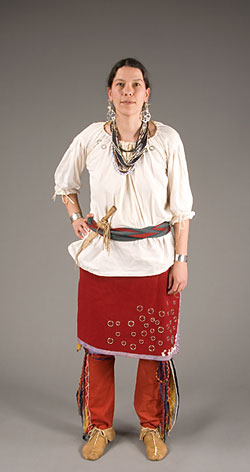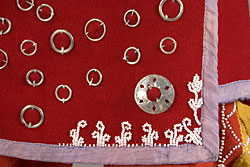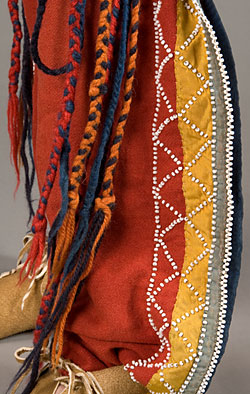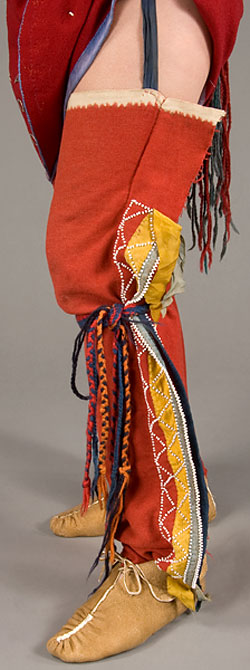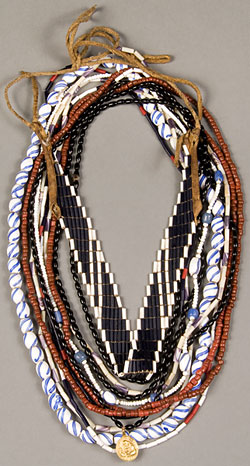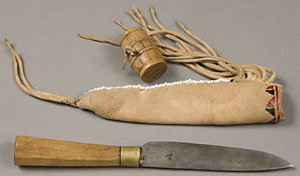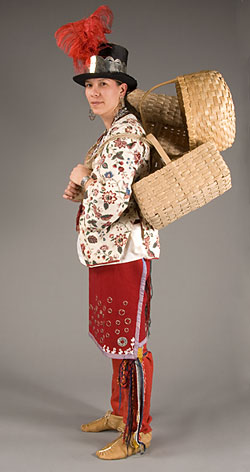




Advanced Search
Dress Up | 1st Person | African American Map | Now Read This | Magic Lens | In the Round | Tool Videos | Architecture | e-Postcards | Chronologies Turns Activities
Wôbanaki Women's Clothing from 1800By 1800, quite a few Wôbanaki people were living in a manner very similar to that of those Americans of European descent. They often wore the same style of clothes, lived in the same kinds of houses, had many of the same types of possessions, and by outward appearance, did not appear to be dramatically different. Most Native people, however, kept some elements of tradition, by wearing moccasins and leggings, decorating their clothing with silver ornaments, or keeping their hair long. Some chose to keep traditional ways of life, and acquire just a few European items. Such is the case for the woman described here, who wears a few items of clothing from the French Canadian people. Wôbanaki people did not have special clothing for sleeping. They slept in what seemed most suited for the season. In the winter this would mean wearing several layers to bed and in the hot weather one might sleep without clothing. Wôbanaki people believed it was a good idea to protect sensitive areas of the body, such as joints, the neck, ears and face, with jewelry, garters, and tattoos. By these means, they believed that dangerous energy or spirits could not enter their bodies. Jewelry with complicated patterns, reflective surfaces, and dangling and jangling pieces such as bells or metal cones, all helped to confuse harmful forces. Porcupine quill embroidery, beading, fringe, and ribbons might be added to the edges of clothing, both to offer protection and to encourage connections with desirable plants and animals.. For instance, the hem of a skirt might be decorated with ribbon, or the flaps on a pair of moccasins might be decorated with beads or porcupine quill embroidery. Among the numerous items available through trade in the 1800s were wool, linen, silk, and cotton cloth, ready-made shirts, knitted wool hats and mittens, glass beads, silver jewelry and metal axe heads and knife blades. Native American people in New England would trade with European people in either Canada or the United States. Items they received might come from England, France, Holland, or as far away as India and China. Go to interactive Flash version
ShiftThis woman wears a cotton shift. It is a trade item and is the same style that was worn by French and English women throughout the 18th century. By the 19th century, this style of shift was not being worn by European women, but Wôbanaki people did not always follow European fashion trends and some continued to wear "old-fashioned" clothing.
Wrap-around SkirtThis skirt is made of wool cloth and is decorated with ribbons, white glass beads, and silver pins known as "brooches". The woman wears more brooches on her shift. The skirt wraps around the waist and a sash is tied on to keep the skirt in place. Wrap skirts and petticoats are called “labizowan”. It is interesting to note that the wool cloth preferred by Wôbanaki people for clothing at this time was usually either red or blue. MoccasinsThese are summer-weight moccasins with a center seam. They are made from the hide of a white-tailed deer. The Abenaki word for all kinds of shoes is "mkezenal". The English adapted this word into “moccasin”.
LeggingsThese are wool leggings, called “medasal”. They are tied to a belt at the waist to keep them up. Leggings were worn for warmth and to protect one's legs when walking through scratchy undergrowth. These leggings have been decorated with ribbons and white glass beads, all received in trade.
Sash & GartersThis woman wears a sash around her waist and garters, called “kiganibial”, tied on just under her knees. The sash and garters are made from wool yarn, using a technique called "fingerweaving". As the name suggests, fingerweaving is a way to weave by just using the fingers, instead of weaving on a loom. The garters help to keep the woman's leggings in place.
Bracelets & EarringsJewelry was worn by men and women. The earrings and bracelets seen here are made of silver. People often slept with their earrings on. Earrings are called “saksohanal”.
NecklacesThis woman wears a variety of necklaces. A necklace is called a called “nôpkoan”, a thing that circles. Several of these “nôpkoanal” are made from glass beads and one strand is wampum (cylindrical beads used for jewelry, ceremonies, and currency). The purple beads are made from quahog clam shells collected from the New England seacoast. The white beads are made from whelk shells. She also wears a woven necklace of blue and white glass wampum.
KnifeA knife could be used for a variety of tasks, from cutting food to carving wood or basket splints. The sheath is decorated with white glass beads and paint. The wooden barrel-shaped bead serves as a toggle to help keep the knife on a belt.
BasketsThese are ash splint baskets that this woman would have made to sell to non-Native people. Baskets are called “abazenodal”, literally meaning containers made from a tree. Many Wôbanaki and other Algonkian Indian women traveled from town to town to sell baskets to their non-Native neighbors.
JacketThe French name for this jacket is a "mantelet". This style of jacket was popular during the second half of the 18th century. It would have been out of style for most European women by 1800, but Eastern Woodland Native American women did not always follow European fashion trends and might wear a piece of clothing that was considered to be old-fashioned. This mantelet is made of a cotton fabric known as "calico". The fabric would have been imported from India, and the jacket would have been received in trade.
HatThe Abenaki word for hat is “asolkwin”. Without the decoration, this is the style of top hat worn by European men. It is composed of felt made from beaver hair. The silver band and red ostrich feather are typical of decorations used by the Wôbanaki people on hats such as this.
|
| |
Home | Online
Collection | Things
To Do | Turns Exhibit | Classroom | Chronologies My
Collection
About This Site | Site
Index | Site Search | Feedback

